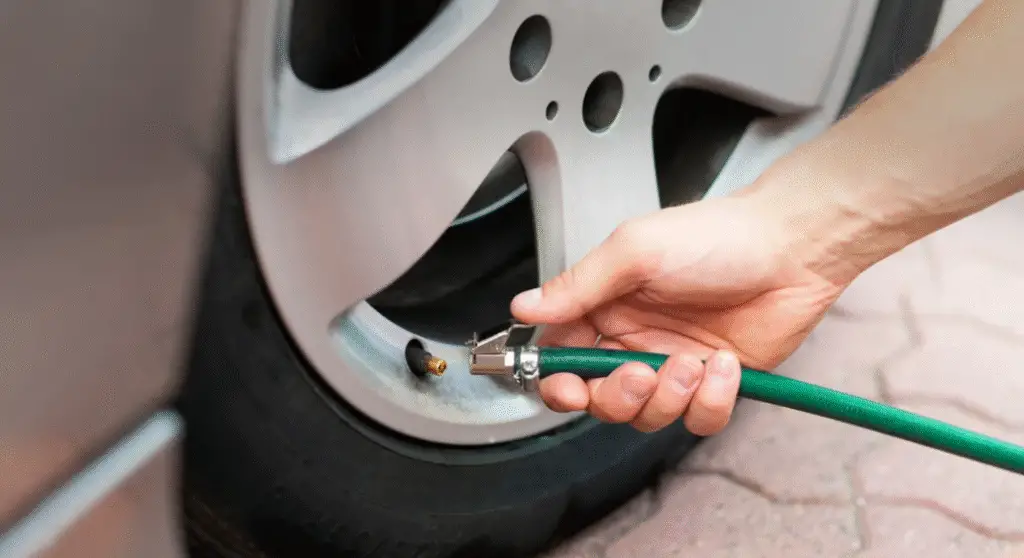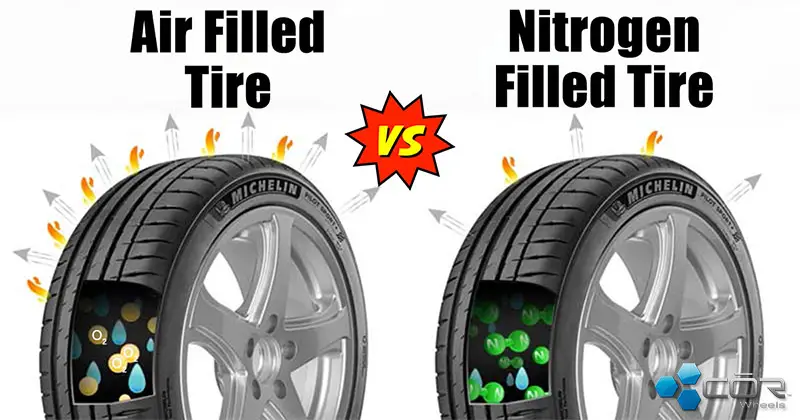Can I put air in a nitrogen tire? Yes, you can put air in a nitrogen-filled tire. However, adding air will dilute the nitrogen concentration and reduce the benefits, such as slower pressure loss and improved tire longevity. It’s safe to do in an emergency, but for optimal performance, it’s best to maintain nitrogen levels.
In recent years, more and more drivers are opting to fill their tires with nitrogen rather than regular air. Nitrogen, with its unique properties, offers several benefits, such as more stable tire pressure, reduced moisture buildup, and enhanced tire longevity. However, you might find yourself in a situation where you need to add air to a nitrogen-filled tire, perhaps due to a low-pressure warning or the unavailability of nitrogen at a service station. So, can you put air in a nitrogen-filled tire?
The good news is that yes, you can add air to a nitrogen-filled tire. However, doing so may dilute the benefits that nitrogen offers, such as slower pressure loss and reduced risk of corrosion.
In this article, we’ll explain the mechanics of nitrogen-filled tires, the impact of mixing air with nitrogen, and what you should know about maintaining tire pressure for optimal performance and safety.

Contents
- 1 What Is Nitrogen Tire Inflation?
- 2 Can I Put Air in a Nitrogen-Filled Tire?
- 3 What Happens When You Mix Air and Nitrogen in a Tire?
- 4 How to Add Air to a Nitrogen-Filled Tire
- 5 Can You Use Regular Air to Replace Nitrogen?
- 6 What Should You Do If You Mix Air and Nitrogen?
- 7 Pros and Cons of Nitrogen in Tires
- 8 Frequently Asked Questions
- 9 Conclusion
What Is Nitrogen Tire Inflation?
Tires are usually filled with compressed air, but increasingly, vehicle owners are opting for nitrogen to inflate their tires. While nitrogen makes up about 78% of the air we breathe, regular air used in tires also contains a substantial amount of oxygen and water vapor, which can lead to moisture buildup inside the tire and contribute to corrosion and pressure loss.
Nitrogen-filled tires, on the other hand, are inflated with a higher concentration of pure nitrogen gas (typically 93% to 99% pure), with very little moisture content.
Benefits of Nitrogen in Tires
The main reasons people choose nitrogen over air include:
- Reduced Pressure Loss: Nitrogen molecules are larger than oxygen molecules, meaning they escape more slowly through the tire’s rubber, reducing the frequency of pressure loss.
- More Stable Pressure: Nitrogen is dry, which prevents moisture buildup inside the tire. This can help maintain more stable tire pressure over a longer period, even during temperature fluctuations.
- Reduced Risk of Oxidation: With less oxygen and moisture in the tire, nitrogen reduces the chances of corrosion inside the tire and on the rim, which can extend tire life.
- Improved Safety and Performance: Some claim that nitrogen-filled tires can enhance safety by maintaining more consistent pressure, improving vehicle handling, and reducing wear.
Can I Put Air in a Nitrogen-Filled Tire?
Yes, you can add air to a nitrogen-filled tire if necessary, but this will reduce the purity of the nitrogen inside the tire. Mixing air with nitrogen won’t harm the tire or vehicle, but it may negate some of the benefits that nitrogen provides. For instance, once you introduce regular air, which contains moisture and oxygen, you might lose some of the advantages of nitrogen, such as better pressure retention and reduced oxidation.
While mixing air and nitrogen is not detrimental, it dilutes the advantages of nitrogen and defeats the purpose of having it in the first place. If the nitrogen levels in the tire drop too much, you may need to have the tire re-filled with nitrogen to restore the intended benefits.
What Happens When You Mix Air and Nitrogen in a Tire?
Mixing air with nitrogen in a tire is not harmful, but it can affect the benefits associated with nitrogen inflation.
1. Loss of Nitrogen Benefits
As mentioned earlier, nitrogen provides several benefits, such as maintaining a stable tire pressure and minimizing moisture-related issues. When you mix air with nitrogen, the nitrogen concentration decreases, and the moisture and oxygen levels in the tire increase. This can lead to:
- Increased Pressure Loss: Oxygen molecules are smaller and escape more quickly than nitrogen molecules, so the tire may lose pressure faster than it would with pure nitrogen.
- Oxidation Risks: The presence of oxygen in the tire can increase the risk of internal corrosion of both the tire and the rim.
- Less Stable Pressure: Temperature fluctuations can lead to more significant pressure changes when there’s a mix of nitrogen and air inside the tire.
2. Impact on Tire Pressure Monitoring Systems (TPMS)
Whether the tire is filled with nitrogen or regular air, tire pressure monitoring systems (TPMS) will continue to work properly. TPMS detects the tire’s internal pressure, regardless of the gas inside. However, frequent pressure loss due to a mix of air and nitrogen could trigger the TPMS to alert you to low pressure more often, requiring regular attention.

How to Add Air to a Nitrogen-Filled Tire
If you find yourself in a situation where you need to top up a nitrogen-filled tire with air, the process is similar to adding air to a regular tire. Here’s how you can do it safely:
- Check the Current Pressure: Before adding air, check the current tire pressure using a reliable tire pressure gauge. This will help you determine how much air you need to add to bring the tire pressure to the manufacturer-recommended level.
- Use a Nitrogen-Compatible Air Pump: While most air pumps will work, it’s best to use one that is compatible with nitrogen inflation. Many service stations that offer nitrogen filling also allow air to be added to nitrogen-filled tires.
- Add the Air Gradually: If you are adding air to a tire that was originally filled with nitrogen, be sure to add it slowly. You don’t want to overinflate the tire or disturb the nitrogen concentration too much.
- Recheck Pressure: After adding air, check the tire pressure again to ensure it’s at the correct level. Keep in mind that the added air will dilute the nitrogen in the tire.
Can You Use Regular Air to Replace Nitrogen?
If you’re unable to find a nitrogen refill station, you can top up or even completely replace nitrogen with regular air without causing harm to the tires. However, doing so will eliminate all the benefits associated with nitrogen inflation, such as more stable tire pressure and better moisture control.
In cases where nitrogen refills are not available or convenient, filling your tire with regular air is a safe and practical solution to maintain proper tire pressure. Just be sure to monitor the pressure regularly, as air-filled tires tend to lose pressure more quickly than nitrogen-filled ones.
What Should You Do If You Mix Air and Nitrogen?
If you have mixed air and nitrogen in your tires, there’s no immediate cause for concern. The main issue is that you won’t get the full benefits of nitrogen inflation. If you’re concerned about the mixture:
- Re-Inflate with Pure Nitrogen: If you want to restore the benefits of nitrogen, you can visit a service station that offers nitrogen tire filling to get your tires re-inflated with pure nitrogen.
- Monitor Tire Pressure Regularly: Since mixing air with nitrogen may cause quicker pressure loss, ensure you check your tire pressure more frequently.
Pros and Cons of Nitrogen in Tires
Before deciding whether nitrogen is the right choice for your tires, it’s important to weigh the advantages and disadvantages. Knowing both the pros and cons can help you make an informed decision about tire inflation.
Pros of Nitrogen-Filled Tires:
- Better Pressure Retention: Nitrogen-filled tires tend to lose pressure more slowly than those filled with regular air.
- Less Moisture Buildup: The lack of moisture helps prevent corrosion and oxidation.
- Improved Tire Life: Reduced oxidation and moisture lead to longer tire life.
Cons of Nitrogen-Filled Tires:
- Limited Availability: Nitrogen refills aren’t available everywhere.
- Higher Cost: Nitrogen inflation can be more expensive than regular air.
- Loss of Benefits When Mixed: Mixing air with nitrogen reduces the advantages of nitrogen-filled tires.
Frequently Asked Questions
Here are some FAQs about putting air in a nitrogen tire –
1. Does mixing air with nitrogen affect tire performance?
Yes, mixing air with nitrogen can affect tire performance by increasing the rate of pressure loss and making the tire more prone to oxidation.
2. Is it bad to add air to a nitrogen-filled tire?
No, it’s not bad to add air to a nitrogen-filled tire, but it will reduce the advantages of nitrogen, such as maintaining stable tire pressure.
3. Can I replace nitrogen with air in my tires?
Yes, you can replace nitrogen with air, but doing so will eliminate the benefits of nitrogen, such as slower pressure loss and reduced moisture buildup.
4. How often should I check the pressure in nitrogen-filled tires?
Even though nitrogen-filled tires hold their pressure longer, it’s still essential to check the tire pressure at least once a month and before long trips.
Conclusion
Adding air to a nitrogen-filled tire won’t harm the tire, but it will reduce the purity of nitrogen and decrease some of the benefits, such as slower pressure loss and reduced oxidation. It’s safe to top up your nitrogen-filled tires with air if necessary, but for optimal performance, it’s best to maintain the nitrogen concentration as much as possible.